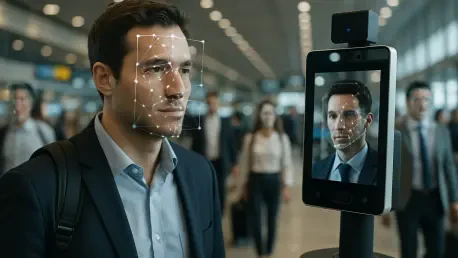Imagine stepping into a bustling airport terminal, rushing to catch a flight, and instead of fumbling for a physical ID, a quick scan of your face verifies your identity in seconds, transforming the travel experience with promises of speed and efficiency. This scenario is becoming a reality at major airports across the United States, where facial recognition technology is currently deployed at 15 key locations, including hubs like Chicago O’Hare, Dallas-Fort Worth, and New York’s JFK, allowing enrolled TSA PreCheck travelers to bypass traditional identification checks. However, as this technology expands, it brings with it a wave of privacy concerns that have caught the attention of lawmakers and critics alike. Questions about data security, consent, and potential biases are fueling a heated debate over how to balance innovation with individual rights. This article delves into the rapid adoption of biometric systems at airports, the safeguards in place, and the legislative efforts aiming to address growing apprehensions.
1. Biometric Technology Takes Flight in Security Screening
The rollout of facial recognition for security screening has marked a significant shift in airport operations, prioritizing speed for travelers. At 15 major U.S. airports, TSA PreCheck members with valid passports can now use Touchless ID, a system that captures a quick photo to confirm identity without the need for physical documents. The Transportation Security Administration emphasizes that these images are deleted within 24 hours after a flight, ensuring they are not repurposed for law enforcement or surveillance. If the biometric match fails, passengers must revert to showing a physical ID, and those who opt out are still processed through standard screening protocols. This initiative reflects a broader push to modernize travel while maintaining security, but it also raises questions about the long-term implications of relying on such technology for identity verification in high-traffic environments.
Beyond TSA’s efforts, U.S. Customs and Border Protection (CBP) is also advancing its biometric capabilities with programs like Enhanced Passenger Processing (EPP). Recently introduced at Nashville International Airport, EPP uses auto-capture technology to photograph travelers before they reach an officer, streamlining identity confirmation and enforcement checks. CBP asserts that this system accelerates inspections for most passengers while allowing officers to focus on higher-risk individuals. Participation remains optional, providing an alternative for those wary of biometric data collection. Yet, the expansion of such systems across different agencies highlights a growing reliance on facial recognition, prompting concerns about consistency in data handling and the potential for errors or misuse in a landscape where millions of travelers pass through daily.
2. Privacy Challenges Spark Legislative Action
As facial recognition technology becomes more prevalent at airports, privacy advocates have voiced significant concerns over the risks associated with biometric data. Historical incidents, such as a 2019 data breach involving a Department of Homeland Security subcontractor where traveler photos were compromised, underscore the vulnerabilities of storing sensitive information. While TSA claims its current systems are encrypted to prevent similar breaches, the fear of unauthorized access or data theft persists among critics. Additionally, there are worries about the lack of explicit consent from passengers, as well as the potential for passive surveillance that could erode personal freedoms. These issues have pushed the conversation beyond technical safeguards to the ethical implications of mass biometric collection in public spaces.
In response to these concerns, lawmakers have introduced measures to impose stricter regulations on the use of facial recognition at airports. The Traveler Privacy Protection Act, currently under consideration, seeks to mandate affirmative consent before any biometric data is collected, prohibit passive surveillance, and establish firm deadlines for deleting stored images. The legislation also calls for annual reviews by the Government Accountability Office to assess the accuracy of these systems and investigate potential biases related to race, age, or gender. Such steps aim to create a framework where innovation does not come at the expense of privacy, ensuring that travelers are informed and protected. The push for these protections reflects a broader recognition that while technology can enhance efficiency, unchecked expansion risks undermining public trust in airport security processes.
3. Balancing Innovation with Traveler Trust
Looking back, the rapid integration of facial recognition at airports revealed a clear tension between technological advancement and privacy safeguards. Agencies like TSA and CBP had prioritized efficiency, deploying systems that streamlined identity verification and reduced wait times for millions of passengers. However, incidents of data vulnerability and the absence of robust consent mechanisms had fueled skepticism among travelers and advocates alike. The response from lawmakers through proposed legislation demonstrated an understanding that public confidence was as critical as operational speed. Reflecting on these developments, it became evident that transparency in data usage and deletion policies had been pivotal in shaping perceptions of biometric tools.
Moving forward, the challenge lies in fostering a system where innovation and privacy coexist harmoniously. Agencies must continue to refine encryption methods and ensure opt-out options are accessible and well-communicated to passengers. Meanwhile, the implementation of legislative measures like mandatory consent and bias audits should be monitored closely to address gaps in accountability. Collaboration between technology providers, government bodies, and privacy groups could pave the way for standards that prioritize traveler rights. Ultimately, the goal should be to build a travel ecosystem where facial recognition enhances security without compromising the fundamental trust that passengers place in these systems.









